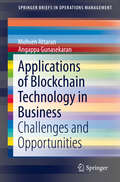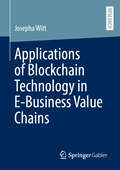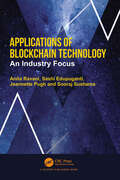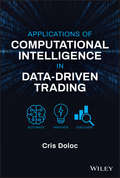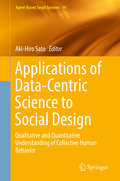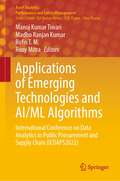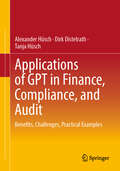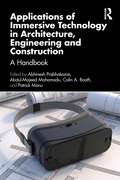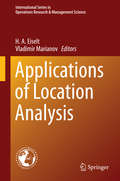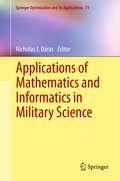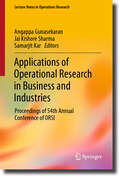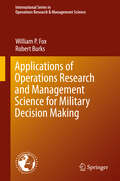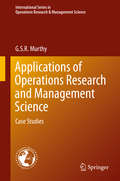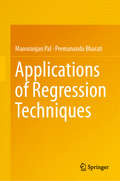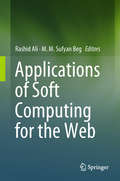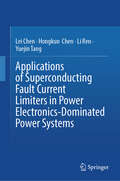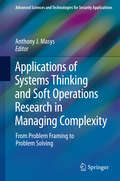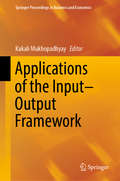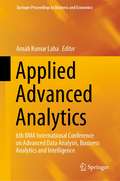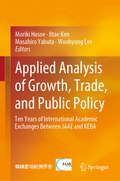- Table View
- List View
Applications of Blockchain Technology in Business: Challenges and Opportunities (SpringerBriefs in Operations Management)
by Angappa Gunasekaran Mohsen AttaranThe book discusses the various ways that blockchain technology is changing the future of money, transactions, government, and business. The first two chapters walk through the foundation of blockchain. Chapters 3–12 look at applications of blockchain in different industries and highlight its exciting new business applications. It show why so many companies are implementing blockchain, and present examples of companies who have successfully employed the technology to improve efficiencies and reduce costs. Chapter 13 highlights blockchain’s powerful potential to foster emerging markets and economies including smart cities, value-based healthcare, decentralized sharing economy, machine to machine transactions, data-sharing marketplace, etc. Chapter 14 offers a conceptual model, provides information and insights, and covers a step-by-step approach to plan and develop blockchain-based technology.
Applications of Blockchain Technology in E-Business Value Chains
by Josepha WittBlockchain Technology (BCT) is explored as a substantial part of the next generation of the Internet affecting business models in e-business. This book explores the application of BCT in e-business focusing on the value creation. The research objective is to examine how and why BCT is used in e-business value chains. This objective is reached through a pragmatic multimethod approach combining four studies. Study 1 summarises the state-of-the-art of approaches to assess a BCT fit for a particular scenario and outlines shortcomings resulting from these approaches. Study 2 provides empirical insights into the usage of BCT in four e-business value chains based on the cases Theta (content), OpenBazaar (commerce), Presearch (context), and Crypviser (connection). Study 3 deepens the insights in the e-commerce value chain. By means of a qualitative content analysis of news articles, various BCT application domains for each e-commerce activity are presented. Study 4 narrows the perspective of analysis to e-negotiations, proposes a BC-based negotiation support system and examines its opportunities and challenges. Finally, an integrative discussion of the findings results in two explanations how BCT is applied in e-business.
Applications of Blockchain Technology: An Industry Focus
by Anita Ravani Sashi Edupuganti Jeannette Pugh Sooraj SushamaBlockchain technology is a disruptive technology that affords businesspeople an opportunity to correct problems of dishonesty, corruption, and poor decision-making. This book crafts blockchain technology for the non-technical expert, to interpret the various applications of blockchain technology through the lens of various industries and creates opportunities for professionals using practical applications and case studies. Blockchain technology is an important platform for businesses to consider as it provides a consensus based, trusted, and transparent system for businesses to operate various critical functions. As such, this book is a first of its kind to take a deep dive into the application of blockchain technology in different sectors. Applications of blockchain technology is explored through understanding of implementation and configuring the use of blockchain technology in real business application. The book provides access to disseminate blockchain technology and its application in a clear and structured manner by assimilating real-world-cases by providing valuable information for business audiences for all business sectors.
Applications of Computational Intelligence in Data-Driven Trading
by Cris Doloc“Life on earth is filled with many mysteries, but perhaps the most challenging of these is the nature of Intelligence.” – Prof. Terrence J. Sejnowski, Computational Neurobiologist The main objective of this book is to create awareness about both the promises and the formidable challenges that the era of Data-Driven Decision-Making and Machine Learning are confronted with, and especially about how these new developments may influence the future of the financial industry. The subject of Financial Machine Learning has attracted a lot of interest recently, specifically because it represents one of the most challenging problem spaces for the applicability of Machine Learning. The author has used a novel approach to introduce the reader to this topic: The first half of the book is a readable and coherent introduction to two modern topics that are not generally considered together: the data-driven paradigm and Computational Intelligence. The second half of the book illustrates a set of Case Studies that are contemporarily relevant to quantitative trading practitioners who are dealing with problems such as trade execution optimization, price dynamics forecast, portfolio management, market making, derivatives valuation, risk, and compliance. The main purpose of this book is pedagogical in nature, and it is specifically aimed at defining an adequate level of engineering and scientific clarity when it comes to the usage of the term “Artificial Intelligence,” especially as it relates to the financial industry. The message conveyed by this book is one of confidence in the possibilities offered by this new era of Data-Intensive Computation. This message is not grounded on the current hype surrounding the latest technologies, but on a deep analysis of their effectiveness and also on the author’s two decades of professional experience as a technologist, quant and academic.
Applications of Data-Centric Science to Social Design: Qualitative and Quantitative Understanding of Collective Human Behavior (Agent-Based Social Systems #14)
by Aki-Hiro SatoThe intention behind this book is to illustrate the deep relation among human behavior, data-centric science, and social design. In fact, these three issues have been independently developing in different fields, although they are, of course, deeply interrelated to one another. Specifically, fundamental understanding of human behavior should be employed for investigating our human society and designing social systems. Insights and both quantitative and qualitative understandings of collective human behavior are quite useful when social systems are designed. Fundamental principles of human behavior, theoretical models of human behavior, and information cascades are addressed as aspects of human behavior. Data-driven investigation of human nature, social behavior, and societal systems are developed as aspects of data-centric science. As design aspects, how to design social systems from heterogeneous memberships is explained. There is also discussion of these three aspects—human behavior, data-centric science, and social design—independently and with regard to the relationships among them.
Applications of Decision Science in Management: Proceedings of International Conference on Decision Science and Management (ICDSM 2022) (Smart Innovation, Systems and Technologies #260)
by Srikanta Patnaik Taosheng Wang Maria Leonilde Rocha Varela Wu Chun Ho JackThis book covers research trends of data science and management involving cutting edge technologies and novel research directions from diverse fields of industries, business and government sectors. It involves usage of various advanced tools and techniques for understanding different data collected at the grassroot level to generate actionable insights for making crucial decisions. This book aims to serve as a reference book for researchers in the area of decision science for management. It covers alternative solutions with innovative ideas and issues from different fields of business management.
Applications of Declarative Programming and Knowledge Management: 19th International Conference, INAP 2011, and 25th Workshop on Logic Programming, WLP 2011, Vienna, Austria, September 28-30, 2011, Revised Selected Papers (Lecture Notes in Computer Science #7773)
by Hans Tompits Salvador Abreu Johannes Oetsch Jörg Pührer Dietmar Seipel Masanobu Umeda Armin WolfThis book constitutes revised selected papers of the 19th International Conference on Applications of Declarative Programming and Knowledge Management, INAP 2011, and the 25th Workshop on Logic Programming, WLP 2011, held in Vienna, Austria, in September 2011. The 19 papers presented in this volume were carefully reviewed and selected from 27 papers presented at the conference and initially a total of 35 submissions. The book also contains the papers of two invited talks. The papers are organized in topical sections on languages; answer-set programming and abductive reasoning; constraints and logic programming; answer-set programming and model expansion; application papers; and system descriptions.
Applications of Emerging Technologies and AI/ML Algorithms: International Conference on Data Analytics in Public Procurement and Supply Chain (ICDAPS2022) (Asset Analytics)
by Manoj Kumar Tiwari Madhu Ranjan Kumar Rofin T. M. Rony MitraThis book provides practical insights into applications of the state-of-the-art of Machine Learning and Artificial Intelligence (AI) for solving intriguing and complex problems in procurement and supply chain management. The application domain includes perishable food supply chain, steel price prediction, electric vehicle charging infrastructure design, contract price negotiation, reverse logistics network design, and demand forecasting. Further, the book highlights the advanced topics in the procurement field, like AI in green procurement and e-procurement in the pharma sector. Furthermore, the book covers applications of well-established methodologies such as heuristics, optimization, game theory, and MCDM based on the nature of the problem. The inclusion of the vaccine supply chain digital twin and blockchain-based procurement signals the significance of the book. This book is a comprehensive guide for industry professionals to understand the power of data analytics, enabling them to improve efficiency and effectiveness in the procurement and supply chain sectors.
Applications of Fuzzy Logic in Decision Making and Management Science (Information Systems Engineering and Management #29)
by Subrata Jana Anirban Sarkar Biswadip Basu Mallik Chiranjibe JanaThe fuzzy logic theory is a branch of mathematics dealing with uncertainty in measurement of any quantity or any estimation. The concept of fuzzy logic uses membership functions. The range of values from various functions or operations determines their construction. A defined rules set can create an application process and membership controls. Fuzzy applications include control system engineering, image processing, power engineering, industrial automation, robotics, consumer electronics and AI. Artificial intelligence, machine learning and expert systems have various applications that address complicated issues. The fuzzy logic inference rules have solved many problems in manufacturing and other industries. Auto engines by Honda, lift control by Mitsubishi Electric, palmtop computers by Hitachi, dishwashers by Matsushita and anti-lock brakes by Nissan are examples of corporations using machine-learning techniques with fuzzy principles. Fuzzy approaches and rule sets interpret computer vision, machine learning and evolution. Fuzzy sets can govern decision rules. Several areas use fuzzy systems in different ways. Computer vision, image processing and meta heuristic evolutionary computing are typical face research applications. Fuzzy theories can optimise and fine-tune the classifier model. Fuzzy theory is used in management, stock market analysis, information retrieval, linguistics, and behavioural science with good results. Fuzzy applications are seen in data mining and stock market prediction. The fuzzy machine learning model in the ensemble pattern accurately classifies and predicts all kinds of tasks. Fuzzy theories help maintain high accuracy. For categorisation and prediction, the ensemble pattern uses fuzzy concepts. The constant growth of fuzzy domain leads to several categorisation and prediction methods. Fuzzy type 2 and intuitionistic fuzzy logic exhibit promise accuracy and versatility. Such fuzzy logic variations can readily overcome the drawbacks of the simple fuzzy model. The book has been developed keeping in view about readers of different categories starting from the students to the professionals and researchers as well. The development of the book and its content layout will be done so meticulously proving the enough insights of the subjects to the readers so that the readers can easily pursue their research concept from the book. Overall the book serve as the purpose of repository of good amount of information and their technical presentations.
Applications of GPT in Finance, Compliance, and Audit: Benefits, Challenges, Practical Examples
by Alexander Hüsch Dirk Distelrath Tanja HüschThis book, authored by three experts with the assistance of GPT, provides comprehensive insights into the applications of generative AI, such as GPT, in the financial sector of businesses. It offers background information, benefits, as well as the challenges and risks associated with implementation. In addition to general applications within companies, specific use cases are also presented, focusing on areas such as controlling, business intelligence, accounting, investor relations, internal audit and control systems, risk management, auditing, and data privacy. The book concludes with a discussion on strategies for utilizing GPT effectively.
Applications of Immersive Technology in Architecture, Engineering and Construction: A Handbook (Spon Research)
by Colin A. Booth Patrick Manu Abdul-Majeed Mahamadu Abhinesh PrabhakaranThis edited book addresses a gap in literature by advancing current understandings of the applications of immersive technology within the architecture, engineering and construction (AEC) sector.Globally, the architecture, engineering and construction (AEC) sector makes an enormous contribution to the socio-economic development of nations, which is primarily evidenced by its creation/provision of the built environment. The sector has, however, often been criticised for inefficiencies, waste and diverse forms of adverse impacts that are associated with the lifecycle of the provision of built assets – design, construction, operations and maintenance and end-of-life phases. Over the years, the inefficiencies, waste and adverse impacts have often been a catalyst for calls and initiatives to transform the AEC sector. The advent of the fourth industrial revolution (commonly referred to as, ‘Industry 4.0’), which entails the automation and digitalisation of production, presents opportunities to leverage emerging technologies to improve the image and productivity of the sector. Prominent among the emerging technologies in the Industry 4.0 era is that of immersive technology, which includes virtual reality, mixed reality and augmented reality. The capability of immersive technology to deliver beneficial impacts for multiple construction sector stakeholders throughout the construction lifecycle has been acknowledged within the industry and this continues to stimulate interest amongst practitioners, policymakers and researchers. Despite this phenomenon, at present there is no dedicated compendium of research-informed text that focusses on the multifaceted applications of immersive technology throughout the lifecycle of the provision of built assets right from concept design to end-of-life.This book thus addresses this gap in literature by advancing current understanding of the applications of immersive technology within the AEC industry. Readers will understand how the technologies are applied, the resulting array of impacts including benefits, drawbacks, challenges and future directions for applications, research and development.
Applications of Location Analysis (International Series in Operations Research & Management Science #232)
by H. A. Eiselt Vladimir MarianovThis book, companion to Foundations of Location Analysis (Springer, 2011), highlights some of the applications of location analysis within the spheres of businesses, those that deal with public services and applications that deal with law enforcement and first responders. While the Foundations book reviewed the theory and first contributions, this book describes how different location techniques have been used to solve real problems. Since many real problems comprise multiple objectives, in this book there is more presence of tools from multicriteria decision making and multiple-objective optimization. The section on business applications looks at such problems as locating bank branches, the potential location of a logistics park, sustainable forest management and layout problems in a hospital, a much more difficult type of problem than mere location problems. The section on public services presents chapters on the design of habitats for wildlife, control of forest fires, the location of intelligent sensors along highways for timely emergency response, locating breast cancer screening centers, an economic analysis for the locations of post offices and school location. The final section of the book includes chapters on the well-known problem of locating fire stations, a model for the location of sensors for travel time information, the problem of police districting, locations of jails, location of Coast Guard vessels and finally, a survey of military applications of location analysis throughout different periods of recent history.
Applications of Mathematics and Informatics in Military Science (Springer Optimization and Its Applications #71)
by Nicholas DarasAnalysis, assessment, and data management are core tools required for operation research analysts. The April 2011 conference held at the Helenic Military Academy addressed these issues with efforts to collect valuable recommendations for improving analysts' capabilities to assess and communicate the necessary qualitative data to military leaders. This unique volume is an outgrowth of the April conference and comprises of contributions from the fields of science, mathematics, and the military, bringing Greek research findings to the world. Topics cover a wide variety of mathematical methods used with application to defense and security. Each contribution considers directions and pursuits of scientists that pertain to the military as well as the theoretical background required for methods, algorithms, and techniques used in military applications. The direction of theoretical results in these applications is conveyed and open problems and future areas of focus are highlighted. A foreword will be composed by a member of N.A.T.O. or a ranking member of the armed forces. Topics covered include: applied OR and military applications, signal processing, scattering, scientific computing and applications, combat simulation and statistical modeling, satellite remote sensing, and applied informatics - cryptography and coding. The contents of this volume will be of interest to a diverse audience including military operations research analysts, the military community at large, and practitioners working with mathematical methods and applications to informatics and military science.
Applications of Operational Research in Business and Industries: Proceedings of 54th Annual Conference of ORSI (Lecture Notes in Operations Research)
by Samarjit Kar Angappa Gunasekaran Jai Kishore SharmaEffective decision-making while trading off the constraints and conflicting multiple objectives under rapid technological developments, massive generation of data, and extreme volatility is of paramount importance to organizations to win over the time-based competition today. While agility is a crucial issue, the firms have been increasingly relying on evidence-based decision-making through intelligent decision support systems driven by computational intelligence and automation to achieve a competitive advantage. The decisions are no longer confined to a specific functional area. Instead, business organizations today find actionable insight for formulating future courses of action by integrating multiple objectives and perspectives. Therefore, multi-objective decision-making plays a critical role in businesses and industries. In this regard, the importance of Operations Research (OR) models and their applications enables the firms to derive optimum solutions subject to various constraints and/or objectives while considering multiple functional areas of the organizations together. Hence, researchers and practitioners have extensively applied OR models to solve various organizational issues related to manufacturing, service, supply chain and logistics management, human resource management, finance, and market analysis, among others. Further, OR models driven by AI have been enabled to provide intelligent decision-support frameworks for achieving sustainable development goals.The present issue provides a unique platform to showcase the contributions of the leading international experts on production systems and business from academia, industry, and government to discuss the issues in intelligent manufacturing, operations management, financial management, supply chain management, and Industry 4.0 in the Artificial Intelligence era. Some of the general (but not specific) scopes of this proceeding entail OR models such as Optimization and Control, Combinatorial Optimization, Queuing Theory, Resource Allocation Models, Linear and Nonlinear Programming Models, Multi-objective and multi-attribute Decision Models, Statistical Quality Control along with AI, Bayesian Data Analysis, Machine Learning and Econometrics and their applications vis-à-vis AI & Data-driven Production Management, Marketing and Retail Management, Financial Management, Human Resource Management, Operations Management, Smart Manufacturing & Industry 4.0, Supply Chain and Logistics Management, Digital Supply Network, Healthcare Administration, Inventory Management, consumer behavior, security analysis, and portfolio management and sustainability. The present issue shall be of interest to the faculty members, students, and scholars of various engineering and social science institutions and universities, along with the practitioners and policymakers of different industries and organizations.
Applications of Operations Research and Management Science for Military Decision Making (International Series in Operations Research & Management Science #283)
by William P. Fox Robert BurksBased on many years of applied research, modeling and educating future decision makers, the authors have selected the critical set of mathematical modeling skills for decision analysis to include in this book. The book focuses on the model formulation and modeling building skills, as well as the technology to support decision analysis. The authors cover many of the main techniques that have been incorporated into their three-course sequence in mathematical modeling for decision making in the Department of Defense Analysis at the Naval Postgraduate School.The primary objective of this book is illustrative in nature. It begins with an introduction to mathematical modeling and a process for formally thinking about difficult problems, illustrating many scenarios and illustrative examples. The book incorporates the necessary mathematical foundations for solving these problems with military applications and related military processes to reinforce the applied nature of the mathematical modeling process.
Applications of Operations Research and Management Science: Case Studies (International Series in Operations Research & Management Science #229)
by G. S. R. MurthyThis book includes case studies that examine the application of operations research to improve or increase efficiency in industry and operational activities. This collection of "living case studies" is all based on the author's 30-year career of consulting and advisory work. These true-to life industrial applications illustrate the research and development of solutions, as well as potential implementation and integration problems that may occur when adopting these methods into a business. Among the topics covered in the chapters include optimization in circuit board manufacturing, Decision Support System (DSS) for plant loading and dispatch planning, as well as development of important test procedures for tyre and pharma industry with shelf life constraints. In particular, the study on deckle optimization should be of great help to managers in paper industry and consultants for development of deckle optimization software. The application of operations research throughout the industry makes it an ideal guide for industrial executives, professionals and practitioners responsible for quality and productivity improvement.
Applications of Regression Techniques
by Manoranjan Pal Premananda BharatiThis book discusses the need to carefully and prudently apply various regression techniques in order to obtain the full benefits. It also describes some of the techniques developed and used by the authors, presenting their innovative ideas regarding the formulation and estimation of regression decomposition models, hidden Markov chain, and the contribution of regressors in the set-theoretic approach, calorie poverty rate, and aggregate growth rate. Each of these techniques has applications that address a number of unanswered questions; for example, regression decomposition techniques reveal intra-household gender inequalities of consumption, intra-household allocation of resources and adult equivalent scales, while Hidden Markov chain models can forecast the results of future elections. Most of these procedures are presented using real-world data, and the techniques can be applied in other similar situations. Showing how difficult questions can be answered by developing simple models with simple interpretation of parameters, the book is a valuable resource for students and researchers in the field of model building.
Applications of Soft Computing for the Web
by Rashid Ali Mm Sufyan BegThis book discusses the applications of different soft computing techniques for the web-based systems and services. The respective chapters highlight recent developments in the field of soft computing applications, from web-based information retrieval to online marketing and online healthcare. In each chapter author endeavor to explain the basic ideas behind the proposed applications in an accessible format for readers who may not possess a background in these fields. This carefully edited book covers a wide range of new applications of soft computing techniques in Web recommender systems, Online documents classification, Online documents summarization, Online document clustering, Online market intelligence, Web usage profiling, Web data extraction, Social network extraction, Question answering systems, Online health care, Web knowledge management, Multimedia information retrieval, Navigation guides, User profiles extraction, Web-based distributed information systems, Web security applications, Internet of Things Applications and so on. The book is aimed for researchers and practitioner who are engaged in developing and applying intelligent systems principles for solving real-life problems. Further, it has been structured so that each chapter can be read independently of the others.
Applications of Superconducting Fault Current Limiters in Power Electronics-Dominated Power Systems
by Lei Chen Hongkun Chen Li Ren Yuejin TangThe book discusses superconducting fault current limiters and their applications in power systems, exploring the principles, simulations and engineering practices, but focusing on systematic applications in traditional and renewable power systems. It provides in-depth studies on a number of major topics such as architecture of superconducting fault current limiter, device design, parameter optimization, prototype testing, co-ordination control and performance evaluation. It also describes multiple application cases of superconducting fault current limiters, which are applied in high voltage direct current transmission systems, active distribution networks, and micro-grids. Offering a comprehensive and systematic overview of practical issues, the book is intended for readers wanting to learn practical approaches for developing superconducting fault current limiters. It also appeals to researchers, engineers and graduate students in various fields, including high-temperature superconducting materials, power system transient stability, and control science and engineering.
Applications of Systems Thinking and Soft Operations Research in Managing Complexity: From Problem Framing to Problem Solving (Advanced Sciences and Technologies for Security Applications)
by Anthony J. MasysThis book captures current trends and developments in the field of systems thinking and soft operations research which can be applied to solve today's problems of dynamic complexity and interdependency. Such 'wicked problems' and messes are seemingly intractable problems characterized as value-laden, ambiguous, and unstable, that resist being tamed by classical problem solving. Actions and interventions associated with this complex problem space can have highly unpredictable and unintended consequences. Examples of such complex problems include health care reform, global climate change, transnational serious and organized crime, terrorism, homeland security, human security, disaster management, and humanitarian aid. Moving towards the development of solutions to these complex problem spaces depends on the lens we use to examine them and how we frame the problem. It will be shown that systems thinking and soft operations research has had great success in contributing to the management of complexity.
Applications of the Input-Output Framework (Springer Proceedings in Business and Economics)
by Kakali MukhopadhyayThis book provides a fresh perspective on the ever-growing relevance of input-output analysis in problem solving. It is based on the “19th National Conference of the Input-Output Research Association of India (IORA)”, held in 2017 in Mumbai, India. The conference promoted the exchange of ideas on input-output analysis and related methods among economists, government officials, policymakers, academicians and industrialists. The book captures the unique ideas of prominent scholars, extends the basic “input-output framework,” analytical tool, outlines the possible impacts of some major policy decisions adopted by the Government of India, and puts forward concrete policy suggestions. In addition, it highlights the versatility of the Leontief model, which is currently being extended to cover a diverse spectrum of policy issues, ranging from agricultural productivity to science and technology and from carbon hotspots to energy and environmental consequences. A perfect blend of theory and application, the book provides a realistic outlook on sensitive economies and interdependencies between sectors.
Applichem (A)
by Marie-Therese FlahertyApplichem has six plants in different countries making the same chemical product. The purpose of this case is to allow students to think about what costs are relevant to management in this process industry environment, about how to define a comparison of costs and productivity across plants, and about how it happens that plants in different parts of the world come to have quite different costs of producing the same product. Finally they can begin to think about what management might do to ensure that productivity improvements made at one plant would be routinely useful for other plants.
Applichem (A) (Abridged)
by Gary P. Pisano Janice H. HammondApplichem manufactures the same chemical product in four plants, each of which is located in a different country. The company has completed a major study comparing the productivity and performance of these plants. Using the data from the study, students must decide which, if any, plants to close. The case requires students to think about the relevant metrics for comparing the performance of plants that operate very differently and in different countries. An important issue is the distinction between physical measures of productivity and financial measures of performance. Finally, the case allows students to think about what management might do to ensure that productivity improvements are shared across the plant network.
Applied Advanced Analytics: 6th IIMA International Conference on Advanced Data Analysis, Business Analytics and Intelligence (Springer Proceedings in Business and Economics)
by Arnab Kumar LahaThis book covers several new areas in the growing field of analytics with some innovative applications in different business contexts, and consists of selected presentations at the 6th IIMA International Conference on Advanced Data Analysis, Business Analytics and Intelligence. The book is conceptually divided in seven parts. The first part gives expository briefs on some topics of current academic and practitioner interests, such as data streams, binary prediction and reliability shock models. In the second part, the contributions look at artificial intelligence applications with chapters related to explainable AI, personalized search and recommendation, and customer retention management. The third part deals with credit risk analytics, with chapters on optimization of credit limits and mitigation of agricultural lending risks. In its fourth part, the book explores analytics and data mining in the retail context. In the fifth part, the book presents some applications of analytics to operations management. This part has chapters related to improvement of furnace operations, forecasting food indices and analytics for improving student learning outcomes. The sixth part has contributions related to adaptive designs in clinical trials, stochastic comparisons of systems with heterogeneous components and stacking of models. The seventh and final part contains chapters related to finance and economics topics, such as role of infrastructure and taxation on economic growth of countries and connectedness of markets with heterogenous agents, The different themes ensure that the book would be of great value to practitioners, post-graduate students, research scholars and faculty teaching advanced business analytics courses.
Applied Analysis of Growth, Trade, and Public Policy: Ten Years of International Academic Exchanges Between JAAE and KEBA
by Woohyung Lee Moriki Hosoe Iltae Kim Masahiro YabutaThis book analyzes the various problems of growth, trade and public policy from the perspective of applied economics, based on research in areas such as public policies, trade and regulation, and development economics. Part 1 investigates the broad problems of growth and regional economy, focusing on economic developments in Japan and Korea. Part 2 discusses trade and foreign investment in Japan, mainly on an empirical basis. Part 3 then examines various public economic policies using applied analysis tools. The papers in this volume have been collected to commemorate ten years of academic exchange between the Japan Association for Applied Economics (JAAE) and the Korean Economics and Business Association (KEBA), and include an applied economic analysis of growth and trade in Korea and Japan.
